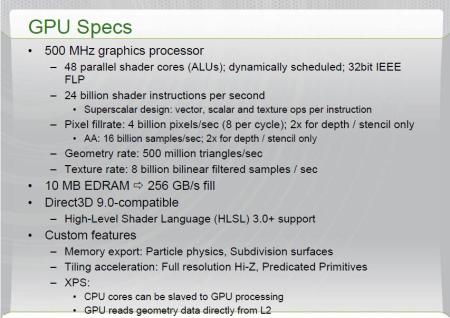The XBOX360 was one of the trendsetters in building a high-end gaming console that attracted teenagers, college students and many grown-up men to the specialized 3D graphics games. Recently, with the advent of more family or group friendly games such as RockBand, the spectrum of users expanded upwards in age to the baby-boomers and downwards to the elementary school kids who like music.
The following will describe the basic architecture of the XBOX360 found from the HotChips Symposium and suggestions for improved system acceleration or consumer friendly apps.
Three years ago 1MByte cache, 500MHz GPU and 512MB GDDR3 memory was considered state-of-the-art.
* In order to make the next-generation XBOX I would think Microsoft would boost the XBOX360 speeds and capacities by 4 to 8 times. Already in 2010, GPU are running at 1GHz and 1GByte GDDR3 is quite affordable on many high-end plug-in 3D graphics cards. Additionally, GDDR5 would probably be adopted in order to quadruple the bandwidth to memory.
The XBOX360 block diagram is shown below:
From a system perspective, 2 SATA are sufficient. With the latest acceptance of Blu-ray as the defacto standard for next-generation HD video decoding, the Blu-ray should be added as a standard on the next-generation XBOX. Maybe it should be called XBOX1080 to promot the 1080p standard and to kind-of show consumers that it’s at least 3 times the power of the XBOX360.
The system memory size is quite small for such a modern device. It should have at least 2 GB to store multiple textures and OS needed memory. Additionally, in past games with my son, I’ve found the waiting time for the transfer from DVD to main memory to be incredibly long. Perhaps, a large SSD or cache can store the DVD contents to allow quickly transfer from that quick access device to main memory or use it as an extended memory space. Additionally, one should allow the consumer to quickly transfer their saved games to their PC. Ease of access of this information to allow them to post to the Web would definitely make it a very popular machine with the techno-savvy show-off kids of this generation.
1MB of level 2 cache is quite small for such a compute intensive CPU. Perhaps 4MB or larger of cache would bump performance by another factor.
*From a usability point of view, 4 USB ports are sufficient but wireless support such as bluetooth would enhance the portability of files such as images or videos from one’s cellphone or PDA to the next generation XBOX.
Similarly for the level1 cache 32KB of two-way set associate cache is small. I would recommend at least 4 times that which would be 128KB for Instruction cache and 128KB for Data cache. It has nice feature to support compressed texture formats, natively. This is a claim but I don’t know what’s the performance factor versus regular instructions. Lastly, for the 3 – 3.2 GHz PowerPC core, I don’t know if it makes sense to allow hardware to treat them as one cpu and use hyper-threading to control distribution of tasks or if this control is done by the compiler/OS. With the advent of dual-core, quad-core or very soon octal-core, I can forsee that the next generation should definitely be octal-core. I think the usage of this would be to allow this gaming console to be multi-functional. In the foreground, one could be playing Halo-6 and in the background, one could be downloading a movie from Netflix or some Microsoft-affiliated downloadable movie partner. For the typical guy, it may not make sense for the real die-hard nerd, it would be a cool factor that no other gaming console can do, and this guy would probably be willing to pay a little extra for it (maybe $50 extra). Finally, speed versus performance has always been the battle. Either the CPU gets bumped up to 6GHz or add more CPU cores. This will be the factor the architect/performance guys need to determine.
The CPU block diagram is shown below. There is no description of FSB (front-side-bus) speed but considering it is a few-years design, I suspect it is at least 500 to 600 MHz. I project that the next generation FSB would be at least twice or quadruple that speed. In that case, the voltage swing may need to be even lower to achieve higher speeds and reduced EMI. There is no technical description of the speed, but I suspect it may be similar signaling levels such as LVDS,PCIE or other high-speed PHY. ARM already supports a XAUI interface with 6.2GHz so I suspect the next-generation may have similar specs.
The XBOX360 GPU specs are quite formidable for a 2005 GPU design. However, with the latest Microsoft Direct X specs with DX11, the DX9-based GPU is a little outdated, and bilinear texture filtering has moved onto trilinear texture filtering. The separate 10MB EDRAM is a very nice feature to have. It allows the GPU to quickly perform localized manipulations without have to fight with the other agents to the main 512MB memory. I suspect the next generation will definitely need to have some high-speed low-latency memory with even larger memory size, maybe 64MB EDRAM. Continuing on with memory analysis, GDDR5 is latest memory interface which is supposed to have 4x the bandwidth of GDDR3. I believe this will certainly be more ubiquitous and affordable for the next generation XBOX console.






